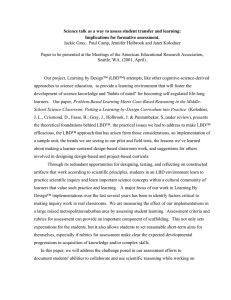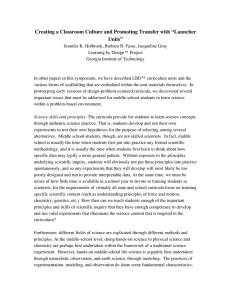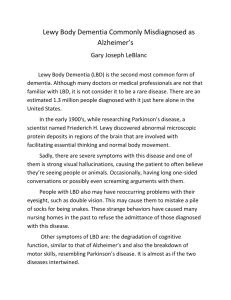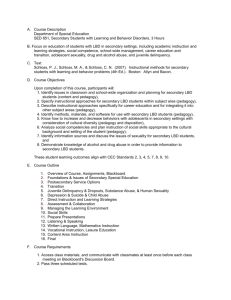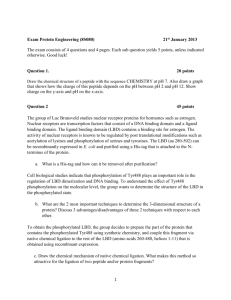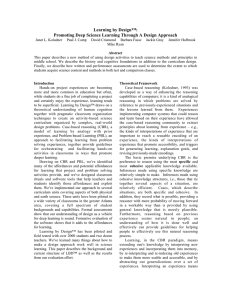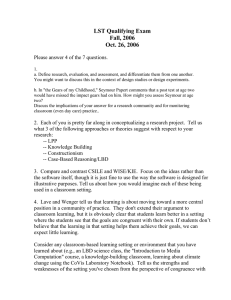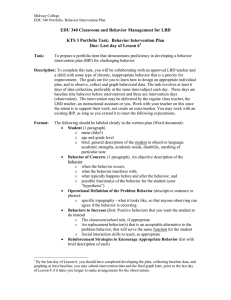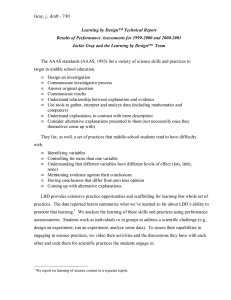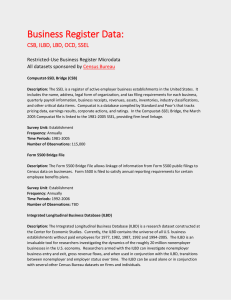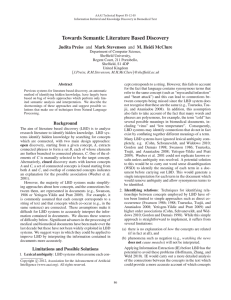Scaffolding Teacher’s Development Through Curriculum Materials
advertisement
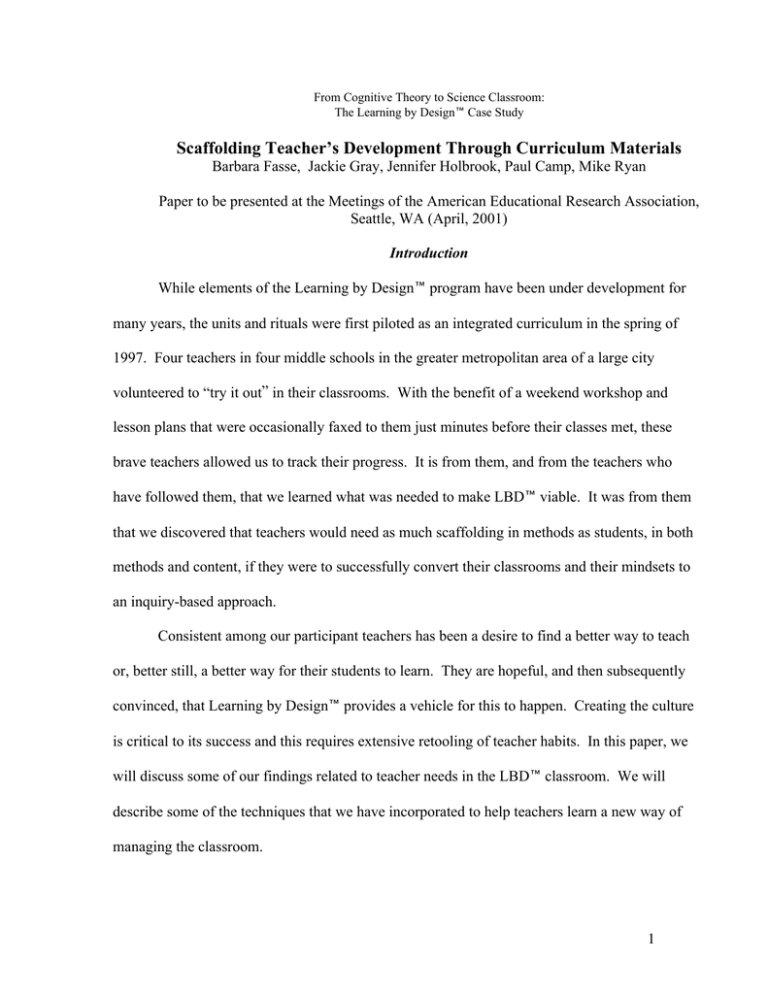
From Cognitive Theory to Science Classroom: The Learning by Design Case Study Scaffolding Teacher’s Development Through Curriculum Materials Barbara Fasse, Jackie Gray, Jennifer Holbrook, Paul Camp, Mike Ryan Paper to be presented at the Meetings of the American Educational Research Association, Seattle, WA (April, 2001) Introduction While elements of the Learning by Design program have been under development for many years, the units and rituals were first piloted as an integrated curriculum in the spring of 1997. Four teachers in four middle schools in the greater metropolitan area of a large city volunteered to “try it out” in their classrooms. With the benefit of a weekend workshop and lesson plans that were occasionally faxed to them just minutes before their classes met, these brave teachers allowed us to track their progress. It is from them, and from the teachers who have followed them, that we learned what was needed to make LBD viable. It was from them that we discovered that teachers would need as much scaffolding in methods as students, in both methods and content, if they were to successfully convert their classrooms and their mindsets to an inquiry-based approach. Consistent among our participant teachers has been a desire to find a better way to teach or, better still, a better way for their students to learn. They are hopeful, and then subsequently convinced, that Learning by Design provides a vehicle for this to happen. Creating the culture is critical to its success and this requires extensive retooling of teacher habits. In this paper, we will discuss some of our findings related to teacher needs in the LBD classroom. We will describe some of the techniques that we have incorporated to help teachers learn a new way of managing the classroom. 1 Identifying Teacher Needs Using a combination of qualitative (focused observations, interview, self-report) and quantitative (performance assessments, content tests) allowed us to see early on (and continue to see during our field test) the importance of establishing a specific LBD classroom culture (Fasse & Kolodner, 2000). The Learning by Design classroom requires that the participants subscribe to a shared set of values, beliefs, and rituals that are different from those of the traditional classrooms that students and teachers are used to. Naively, we originally believed that the vocabulary of educational reform (i.e., inquiry-based, student-centered, hands-on) was defined roughly the same by everybody—particularly by the converted. But, when we saw LBD teachers actually withholding their knowledge of science content and/or methods from students in the spirit of “giving them room to discover it themselves”, we knew we had to operationally define the terms and their meanings. In this case, for example, we replaced student-centered with learner-centered to lead teachers away from the notion of student-centered as the absence of teacher interaction. When we discovered teachers allowing students to persistently repeat the same mistakes (for example, measurement errors) without correction or redirection, we knew we had to be specific about teacher roles in the inquiry-based classroom. When we realized that some science teachers had little or no training specific to the subject that they were assigned to teach, we knew LBD teacher training and texts would need to provide content knowledge and support. We found that frequently the notion of a non-traditional classroom was one in which the students milled around unhindered by the teacher until knowledge popped into their heads-some sort of dichotomous opposites with the traditional classroom as teacher-driven, structured, goal-oriented on one side and the non-traditional classroom as student-driven, unstructured, 2 loosey-goosey on the other. When we compared less-than-successful LBD classrooms where chaos reigned with more structured successful ones (that is, where the design challenges were met, the science content was learned, both the teachers and the students had confidence that the time had been well-spent) where the teacher had a firm grasp on student behavior, respect for the students, rigorous expectations for performance, and a transmittable sense of the value of the activity, we knew that creating an LBD culture would require a specific set of teacher behaviors which we would have to factor into the design of curriculum materials and training. In retrospect, it seems obvious that teachers learn according to the same cognitive principles as their students and shouldn’t be left to fend for themselves. We sought a middle ground—studentdriven but well-paced by structure. We’ve discovered many practical needs in putting together a curriculum approach that can be broadly adopted (Hmelo et al., 2000; Holbrook & Kolodner, 2000). • Some teachers are not familiar with inquiry; we’ve had to find ways to make inquiry happen in the classroom despite the fact that teachers are unfamiliar with it. • Some teachers are not used to being facilitators; we had to find ways of helping them learn those skills on the job. • Some teachers and students are not used to classrooms where everyone helps everyone else learn; we had to design ways to introduce a collaborative culture to the classroom, and we had to do it in ways that would allow both teachers and students to gradually become proficient and comfortable. • Most students and teachers are not tinkerers. We had to find ways to allow them to be successful at design and construction nonetheless. • Some teachers don’t deeply know the science they are helping their students learn, and while design activities have many powerful affordances for science learning, it takes careful facilitation to help students make all of the connections. We had to find ways to connect the design activities and science content in ways that would allow the students and teachers to make the connections well. • Finally, iteration towards a refined understanding is not a common practice in schools, nor is application of what’s been learned. When there is so much to learn and so little time to learn it, teachers are used to going over something once, helping students get the most they can from it, and going on. Yet we know that it takes time and experience to learn deeply and that deep learning requires iterative application, feedback, explanation, and revision. We had to design ways of making sure that teachers come to appreciate the importance of iteration and don’t drop it from the sequence of activities in a curriculum unit. 3 Putting It Into Practice Our solutions to these problems include a ritualized cycle of classroom practices that are repeated from module to module in each design challenge and that integrate doing and reflection in “natural” ways; the design of the launcher units that introduce students to the practices of scientists and engineers, help teachers create a culture in the classroom, and provide teachers with time to hone their facilitation skills; paper-and-pencil design diary pages that scaffold design practices, science practices, reflection, and collaboration; an approach to design through redesign; integration of design rules-of-thumb as a device for bridging the gap between design experiences and science principles; and employment of “pin-up sessions” and “gallery walks” (enhanced show and tell) to promote reflection and articulation. The cycle of rituals imposes the pacing that we observed to be frequently missing. Learning by Design Rituals We’ve learned about how to scaffold introduction of new pedagogy for both teachers and students – in particular, the use of the “launcher unit” to introduce practices and the set of rituals we’ve developed for classroom practice. By “rituals,” we refer to activities with well-articulated frameworks that are associated with particular goals. The rituals provide the students and teacher with a collaborative structure for organizing knowledge (whiteboard), presenting design ideas (pinup), reporting results of the tests of those ideas (gallery walk), and abstracting from the experience (rules of thumb). While all could be thought of as peer presentations, we ask students and teachers to think about each one as a different kind of activity (though we point out the similarities as well). Each requires a different kind of presentation – when presenting investigative results, one discusses procedures carried out; when presenting ideas, one focuses on using evidence to justify; when presenting project experiences, one tries to explain. By 4 separating them out as different rituals, we’ve been able to make clear to teachers and students what’s expected – for students, the content of the presentation that’s expected and for teachers, the kinds of facilitation that might be required, the kinds of abstractions or generalizations that she/he might help the students identify, and the kinds of scientific thinking to promote. Together, these innovations make the introduction of new ways of teaching and the discussion of classroom practices manageable. Student Texts After observing that teachers do not necessarily use their teacher’s manual during instruction, we chose to write our student materials in ways that scaffold both the students and the teachers. For example, one difficulty teachers face is remembering the cycle of activities—what comes after what in the sequence and how they are tied together. We address that by providing in the student texts both a general overview of the LBD cycle and a specific overview, for each unit and module of a unit, of the sequence of activities and how they follow from each other. In addition, the cycle itself is embedded in the text alongside content and activity instructions as co-equal components. While teachers may break for, say, whiteboarding, whenever it seems appropriate, we have included in the books specific calls for whiteboarding sessions at appropriate times. Both students and teachers are enabled to recognize moments when reflection is important, as well as the form that reflection should take. Ethnographic observations suggest success in this design as the class gradually takes over management of the cycle. Another issue for teachers is how to manage particular classroom rituals—e.g., whiteboarding and presentations. Our student texts hold descriptions, written for the students, of those rituals and the ways they should involve themselves in them. These descriptions are purposefully redundant and iterative. Each time that the description appears, the students is 5 prompted to reconsider their first work, suggestions are made for how they may want to revisit what they originally wrote or thought or created. A framework is established over time for students to reflect upon previous work and improve or extend it. (See Appendix 1 for an example of several pages from the student text that provide guidance with cases, whiteboarding and rules of thumb.) The Design Diary section in the back of the student book contains activities that scaffold both the design challenge experience and the science content for the students. Pointers in the margin refer the students to the pages so that they know when a particular element might be called for even if the teacher forgets. (See Appendix 2 for an example from the student book.) Additionally, teachers report difficulty knowing what kinds of questions to ask students to help them with their inquiry. In the text, we provide guidelines for students of the kinds of questions they ought to be asking other students. (See Appendix 3 for an example from the student book.) Making the practices, sequences, and expectations available to students scaffolds both student and teacher at the same time. Teacher Training We’ve also had extensive experience designing the teacher development segment of our project – both the formal and informal parts. Teachers learn science and pedagogy, in our workshops, by engaging in LBD as their students would, then reflecting on their roles as students and the roles of their facilitators. Then they try out skills with students and reflect on those together. We help them learn the practices and the foundations behind them. There are many layers of things happening in the LBD classroom. The teacher is simultaneously monitoring and facilitating science content, science methods, the rituals, the design challenge—conceptualizing, fabricating, testing, iteration—while at the same time 6 managing the general participation of the students. The teacher workshop is designed to first model this complex network of expectations for the teachers then to give them a guided opportunity to practice with students before stepping into their own classrooms. First-time LBD teachers report struggling with getting it all in. They fret that they are leaving parts out and, only through experience with their own classes, coming to an understanding of how to better employ any one or all of the elements. We provide on-going encouragement and support via email, periodic regional meetings, phone conversations, visits to their classrooms, and by trying to encourage them to communicate with each other for guidance and advice. Software In the units we’ve developed, software is used to scaffold reflection (Kolodner & Nagel, 1999). Students in some LBD classes use SMILE, a WEB-based collaborative tool, to help as they prepare for classroom presentations. Its scaffolding helps them with such things as structuring what they want to say, connecting goals to plans to what they did to results, and using evidence to justify claims. It provides reminders, as well, as they are planning investigations, helping them to sort out what they will vary from what they are holding constant. Presentations developed using SMILE are saved as peer publications, and students refer back to each others’ results and ideas as they are progressing forward with their own ideas. Additionally, we have set up a user-editable WEB page, SWIKI, for the teachers. This provides a venue for the teachers to communicate with each other--share what they have learned and ask for assistance--and to receive help from each other and the LBD staff. 7 Preliminary Results & Conclusions We are in the process of analyzing data from our implementations, and the trends we are seeing are encouraging. Our content pre- and post- tests show that LBD students have larger gains than comparison students in their science content knowledge. Analysis of our performance post-tests show that LBD students far outperform comparison students on several dimensions – ability to recall prior knowledge, applicability of what they recall, self-monitoring, and engagement in productive collaboration (Gray, Camp, Holbrook & Kolodner, 2001). As well, our analysis shows that some teachers are able to learn science content as they are facilitating LBD units, that the launcher unit indeed helps them create culture in the classroom and practice the new skills they are learning, and that students achieve success even in the classrooms of beginner teachers and those who are struggling with managing inquiry, managing the “chaos” of a project-based classroom, and learning new ways of maintaining control (Kolodner, et al., 1998, in preparation). Teachers report (and we have observed) that they need help: a) creating an inquiry-based (LBD or PBL) classroom culture; b) keeping up with the rituals and expectations as they occur; c) converting their thinking and practices from traditional methods to something new; and d) finding the science. Data from performance assessments, content tests, ethnographic observations, and interviews indicate that Learning by Design student texts, teacher training, software, and on-going professional development work together to provide the scaffolding teachers need to gain confidence and skill when implementing an inquiry-based classroom environment. 8 References Fasse, B. B. & Kolodner, J. L. (2000). Evaluating classroom practices using qualitative methods: Defining and refining the process. In proceedings International Conference of Learning Sciences 2000 (ICLS), in press. Gray, J., Camp, P., Holbrook, J., & Kolodner, J. L., (2001). Science talk as a way to assess student transfer and learning: Implications for formative assessment. Paper to be presented at the Meeting of the American Educational Research Association, Seattle, WA. Hmelo, C.E., Holton, D.L., Kolodner, J.L. (2000). Designing to Learn About Complex Systems. Journal of the Learning Sciences, Vol. 9, No. 3. Holbrook, J. & Kolodner, J.L. (2000). Scaffolding the Development of an Inquiry-Based (Science) Classroom. In Proceedings, International Conference of the Learning Science 2000 (ICLS) Kolodner, J.L. & Nagel, K. (1999). The Design Discussion Area: A Collaborative Learning Tool in Support of Learning from Problem-Solving and Design Activities. Proceedings of the International Conference on Computer Support for Collaborative Learning (CSCL ’99). Palo Alton, CA, pp. 300-307. 9 Appendix 1 Ritual iteration (cases, whiteboarding, and Rules of Thumb) in student text: 10 Ritual iteration (cases, whiteboarding and Rules of Thumb) in student text (cont.): 11 Ritual iteration (cases, whiteboard, and Rules of Thumb) in student text (cont.): 12 Ritual iteration (cases, whiteboard, and Rules of Thumb) in student text (cont.): 13 Appendix 2 Example from student book of page 97 from text and associated Design Diary page 5: Example from student book of Design Diary page scaffolding gallery walk ritual: 14 Appendix 3 Example from student text of inquiry-based questions for students: 15
